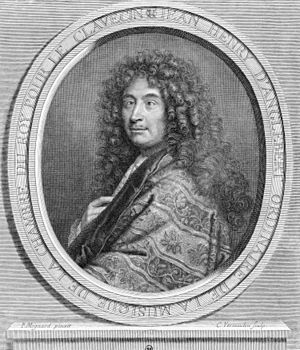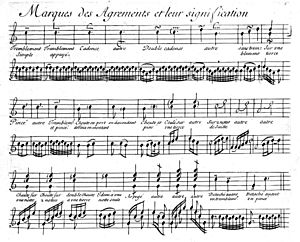Jean-Henri d'Anglebert facts for kids
Jean-Henri d'Anglebert (born 1 April 1629 – died 23 April 1691) was a French composer, harpsichordist, and organist. He was one of the most important keyboard composers of his time.
Life of Jean-Henri d'Anglebert
Jean-Henri d'Anglebert's father was a shoemaker in Bar-le-Duc, France. We don't know much about d'Anglebert's early life or how he learned music. Some people think he might have been taught by Jacques Champion de Chambonnières, another famous harpsichord player. This is because d'Anglebert later wrote a special piece of music to honor Chambonnières.
The oldest music we have by d'Anglebert is from the 1650s. It also includes music by other top French harpsichordists like Louis Couperin and Chambonnières. This shows that d'Anglebert was already connected with important musicians by then.
In 1659, d'Anglebert married Magdelaine Champagne in Paris. At this time, he was described as a "bourgeois de Paris," which means he was a respected citizen. This suggests he was already settled in Paris, but we don't know how he moved there from Bar-le-Duc.
D'Anglebert's career in Paris likely started as an organist at a church. In 1660, he became the harpsichordist for Philippe I, Duke of Orléans, who was the King's younger brother. He held this job for many years.
In 1662, he took over the duties of royal harpsichordist from Chambonnières. Chambonnières kept the salary, but d'Anglebert did the work. D'Anglebert served as the royal harpsichordist until 1674, when his son, Jean-Baptiste-Henry, took over the role. After 1679, d'Anglebert worked for the Dauphine Duchess Maria Anna Victoria of Bavaria. She died in 1690, and d'Anglebert died the next year, in 1691.
His only published work, Pièces de clavecin, came out just two years before he died. Most of his other music, including more harpsichord pieces and some organ works, survives in handwritten copies.
Musical Works of Jean-Henri d'Anglebert
D'Anglebert's most important work is a collection of four harpsichord suites. These were published in Paris in 1689 and called Pièces de clavecin. The book was dedicated to Marie Anne de Bourbon, who was a very good amateur harpsichord player.
This collection is very important for French harpsichord music. It shows d'Anglebert's great skill in counterpoint, which is the art of combining different musical lines. The book was also printed with great care, setting a new standard for how music was published.
One special part of the book is d'Anglebert's detailed table of ornaments. These are small musical decorations added to notes. His table was the most advanced of its kind before François Couperin's, which appeared much later. Even famous composers like J.S. Bach and Rameau used d'Anglebert's table as a guide.
The Pièces de clavecin also includes d'Anglebert's own original pieces and his arrangements of orchestral music by Jean-Baptiste Lully. D'Anglebert's arrangements are considered some of the best of their kind. He experimented with how the music sounded to make the harpsichord sound like a whole orchestra.
Most of d'Anglebert's other pieces are found in handwritten books. One of these books has harpsichord arrangements of lute pieces by other composers. These are special because other major French harpsichord composers didn't usually make such arrangements. Another book shows d'Anglebert trying to invent a new way to write keyboard music. He wanted to make it easier to write down certain types of complex harpsichord textures.
D'Anglebert's only surviving organ works are five fugues and a quatuor. The fugues are all based on variations of the same musical idea. The quatuor is a four-voice organ piece. It is built around three themes and is meant to be played on three keyboards and the pedal keyboard of the organ.
See also
 In Spanish: Jean-Henri d'Anglebert para niños
In Spanish: Jean-Henri d'Anglebert para niños



